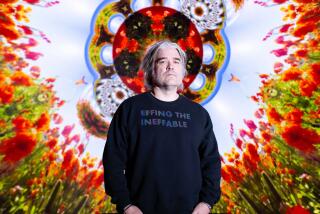‘Cosmos’ recap: Finding the secret code that’s ‘Hiding in the Light’
- Share via
The title of this week’s episode of “Cosmos” is “Hiding in the Light,” which — I must confess — evoked memories of a classic episode of “The X-Files,” in which Mulder and Scully investigate the Boss from Hell: a giant insect monster who “hides in the light” and whose bite turns employees into zombies. It is only when the lights go out that Mulder glimpses the outline of the monster instead of the man.
There were no Bug-Monsters or zombies in the “Cosmos” episode, but there were a Chinese philosopher, an Arab astronomer, and an orphaned German boy who grew up to be a leading optical scientist. And collectively they made for one of the strongest, most coherent episodes in the series, as host Neil de Grasse Tyson showed us how so much about our universe is written in the secret code of light.
We start in an ancient cave, where a quirk of the light casts an upside-down image on the wall of an animal grazing just outside. This is a naturally occurring “camera obscura” (Latin for “dark room”), the precursor to the pinhole camera. In its simplest form, it is little more than a small hole in a shade or a wall, through which light passes from a sunlit garden, for example, into a darkened room, projecting an inverted image of the scene onto a wall opposite the hole.
PHOTOSD: TV shows and their spinoffs
The Chinese astronomer Mo Tze (or Mozi) enraptured onlookers by performing “shadow plays” with a camera obscura. But this knowledge was lost for the next 1,000 years after the writings of Mo Tze, Confucius and others from that era were burned during the reign of Emperor Chin, who wasn’t big on freedom of thought or speech. “Science needs the light of free expression to flourish,” Tyson observes. “It depends on fearless questioning of authority and the open exchange of ideas.”
That was just the kind of intellectual environment that flourished during the Islamic Golden Age, when caliphs collected books instead of burning them; many of the surviving texts from ancient Greece exist because the caliphs of this era had them translated and thus preserved.
It was still possible to run afoul of a caliph if said ruler happened to be mad, as the unfortunate 11th century Arabian scholar Ibn Al-Haytham (Alhazen) of Basra discovered. He reportedly used portable camera obscura tent rooms for solar observation, but his most notable insights into the nature of light came about because he spent years under house arrest on the order of the Mad Caliph (al-Hakim). Ever-resourceful, he turned his prison into a laboratory, performing experiments with light, which is how he determined that light moves in straight lines.
PHOTOS: WGA’s top 101 TV shows
Several hundred years later, Isaac Newton performed his famous prism experiment, by which he discovered that the white light from the sun is really a mix of all the colors of the rainbow. And in 1800, William Herschel discovered that there were “colors” of light in the spectrum beyond what human eyes could detect, like the infrared regime, which we experience as heat, or ultraviolet light.
Alas, as Tyson points out, Newton never got around to using a lens to take a closer look at the colors of the spectrum. That’s what Joseph Frauenhoefer did 150 years later in Bavaria. He was a master of glasswork, designing high-quality lenses for telescopes and microcopes. He was the first to take a closer look at sunlight passed through a prism and noticed dark lines in the spectrum. Those are absorption lines: different elements absorb some colors of the spectrum and reflect others — each element has its own unique atomic fingerprint.
This effect is the basis for spectroscopy, which is how today’s astronomers can analyze the spectra from distant stars or planets and figure out all the elements that comprise them, just by reading those chemical signatures. So many secrets of our universe were, quite literally, hiding in the light.
PHOTOS: Behind the scenes of movies and TV
As a series to date, “Cosmos” has lacked the single-minded, unifying vision of Carl Sagan — a real strength of the original series. And it showed in the erratic organization and unfocused rambling that marred the otherwise enjoyable prior episodes. Here, the makers finally seem to be finding their footing, with smooth progression between segments that makes sense and just enough colorful trivia to enliven the narrative without derailing the plot. Tyson too seems to be relaxing into his role as host, with nary a trace of self-consciousness in his narration.
This episode concludes with a wonderful sequence showcasing the same image of New York City, viewed through the filters of various wavelengths of light: visible, infrared, ultraviolent, X-ray, gamma ray, microwave, and even a radio image. Different kinds of light can reveal new, unexpected details in the same scene — aspects of our world we might otherwise have missed without donning those particular filters. It’s how physicists discovered the cosmic microwave background radiation, the “afterglow” from the Big Bang, and found evidence for dark matter in the so-called Bullet Cluster. Every time we look at the night sky in a different part of the spectrum, we learn something new.
So perhaps “The X-Files” episode was right in that regard: There are lots of things hiding in the light, and we can spot them — if we just know how to see.
ALSO:
‘Cosmos’ recap: Starts with a big bang
Review: Neil deGrasse Tyson’s ‘Cosmos’ a fascinating, fun place to be
Watch ‘Cosmos’ Q&A with Neil deGrasse Tyson and Seth MacFarlane
More to Read
The complete guide to home viewing
Get Screen Gab for everything about the TV shows and streaming movies everyone’s talking about.
You may occasionally receive promotional content from the Los Angeles Times.






